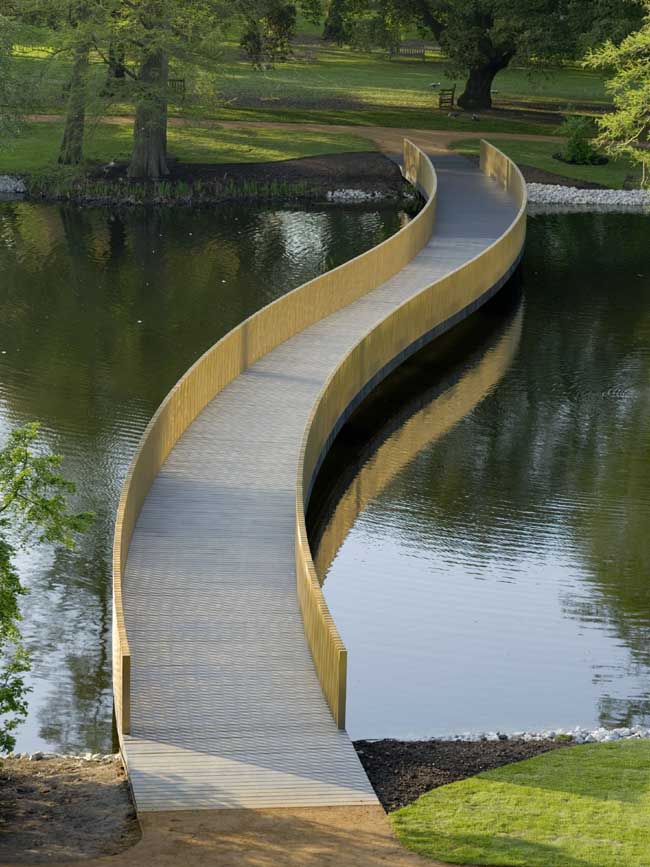 |
| Boston's Public Garden. Source: Te-Ming Chang |
The footbridge, Public Garden, Boston, Massachusetts, 1867 designed by William G. Preston
It was the world's shortest functioning suspension bridge before its conversion to a girder bridge in 1921. Its original suspension system is now merely decorative.
sometimes jokingly referred to as the "Bridge of Size," a play on words based on the small bridge's vastly overbuilt look -- Wikipedia
 |
| Source: Machado and Silvetti Associates |
Robert F. Wagner, Jr. Park, New York City, New York, 1996 deisgned by Machado and Silvetti Associates
The design of the park comprises three main components: a pair of allées that brings pedestrians towards the main park entrance, extending the sidewalks of Battery Place coming from the north and of Battery Park from the south; a pair of pavilions connected by a bridge constituting the main building; and a lawn terrace framed by continuous paths and benches. This "Y" shaped architectural ensemble is the backbone of the park, resting in gardens and fields of grass that connect to the Battery Park City Esplanade and to Battery Park. -- architect's web site
 |
| Source: Bernard Tschumi Architects |
Parc de la Villette, Paris, France, 1998 designed by Bernard Tschumi Architects
Read a post from ArchDailyLa Villette could be conceived of as one of the largest buildings ever constructed — a discontinuous building but a single structure nevertheless, overlapping the site’s existing features and articulating new activities. It opposes the landscape notion of Olmstead, widespread during the 19th century, that “in the park, the city is not supposed to exist.” Instead, it proposes a social and cultural park with activities ... -- architect's web site
 |
| Source: wikipedia.org |
Foot bridge, Jardin de Reuilly, Paris, France, designed by landscape architect Jacques Vergely and architect Philippe Mathieux
 |
| Source: wikipedia.org |
The Henderson Waves Bridge, Singapore designed by IJP Corporation, London, and RSP Architects Planners and Engineers (PTE) ltd Singapore
this 274 metre-long pedestrian bridge that spans Henderson Road to connect Mount Faber Park to Telok Blangah Hill Park. At 36m above Henderson Road, Henderson Waves is the highest pedestrian bridge in Singapore.
The bridge is also worth visiting for its artistic, distinctive wave-like structure consisting of a series of undulating curved "ribs". These “ribs” also double up as alcoves providing shelter to the public.
The bridge takes on a different look at night, with the wave-form illuminated with attractive LED light from 7pm to 2am daily. -- official web site.
 |
| Source: Te-Ming Chang |
BP Pedestrian Bridge, Millenium Park, Chicago, 2004 designed by Frank Gehry
Gehry took the relatively unglamorous task of building a pedestrian bridge and made is an immersing experience. One method was through the use of a wood deck. As people make their way across and back it creates a pleasant clip-clomping noise. Something familiar and expected in what might otherwise be a too-technologically advanced environment. After all, this is a park, so balancing out his distinctly man-made style with some natural materials is more than appropriate. -- Glass, Steel and Stone
Read a description from SOM's web site.
 |
| Source: RBG Kew e-architect.co.uk.com |
Bridge at Royal Botanic Gardens Kew, London, UK, 2006 designed by John Pawson Architects
....the 'sinuous Line of Grace', the walkway plots a serpentine path across the water, the constantly curving route yielding its secrets only gradually. The deck is set the minimum possible distance from the lake's surface, allowing those crossing to feel that they are literally taking a walk across the water. This sense of proximity is enhanced by glimpsed views of the lake between the deck treads and by the near invisibility of the supporting structures which lends the bridge a quality of sculptural abstraction. -- e-ArcitectRead more from architect's web site
 |
| Source: Peter Durant archdaily.com |
Kew Tree Top Walkway & Rhizotron, Kew Gardens, Brentford Gate, London TW9 3AB, UK, 2008 designed by Marks Barfield Architects
The Walkway is a thrilling experience, taking visitors 18m high into the tree canopies for a birds-eye view of Kew, providing insights into the special role of trees in our breathing planet and the intimate views of a deciduous woodland and its inhabitants from within the tranquillity of the leaves. Inspiration for the walkway was drawn from the ancient Fibonacci sequence found repeatedly in nature. -- ArchDaily
 |
| Source: Wikipedia.org |
Nichols Bridgeway, Art Institute of Chicago, Chicago, Illinois, USA, 2009 designed by Renzo Piano
A new pedestrian bridge, which links Millennium Park and the Art Institute of Chicago's Modern Wing, is a walk through the treetops, a sidewalk soaring through the sky. Climb the Nichols Bridgeway, as this sloping, 620-foot-long span is called, and you're hovering over Monroe Street, as though you are in a helicopter. -- Cityscape
 |
| Source: architectural-review.com |
Path In The Forest, Tallinn, Estonia, 2011 designed by Tetsuo Kondo
Read a post from the Pop-Up CityAs part of Tallinn’s hosting of the 2011 European Capital of Culture, architects and designers were invited to create a series of temporary installations across the city. Deep in Kadriorg Park, Japanese architect Tetsuo Kondo fabricated a looping steel walkway that scrolls and spirals up into the tree canopy. -- Architectural Review
Read a post from ArchDaily
 |
| Source: Adam Harrower archdaily.com |
Treetop Walkway in Kirstenbosch Botanical Garden, Cape Town, South Africa, 2014 designed by Mark Thomas Architects
Read another post from ArchDailyLocated 11 metres above the ground, the galvanised steel and timber structure offers breathtaking views from the treetops. The project, a collaboration between Mark Thomas Architects and Henry Fagan & Partners consulting engineers, has been nicknamed Boomslang - a large, highly venomous African tree snake – due to its elevated, twisting form. -- ArchDaily
No comments:
Post a Comment